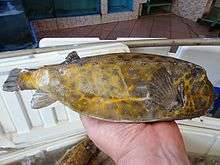Yellow boxfish
| Yellow boxfish | |
|---|---|
_02.jpg) | |
| Scientific classification | |
| Kingdom: | Animalia |
| Phylum: | Chordata |
| Class: | Actinopterygii |
| Order: | Tetraodontiformes |
| Family: | Ostraciidae |
| Genus: | Ostracion |
| Species: | O. cubicus |
| Binomial name | |
| Ostracion cubicus Linnaeus, 1758 | |
| Synonyms | |
The yellow boxfish (Ostracion cubicus) is a species of boxfish. It can be found in reefs throughout the Pacific Ocean and Indian Ocean as well as the south eastern Atlantic Ocean. It reaches a maximum length of 45 centimetres (18 in).
As the name suggests, it is box-shaped. When juvenile, it is bright yellow in color. As it ages, the brightness fades and very old specimens will have blue-grey colouration with faded yellow. It feeds mainly on algae, but will also feed on sponges, crustaceans and molluscs.
The fish's diet consists of marine algae, worms, crustaceans, molluscs, and small fish.[1]
When stressed or injured it releases poisonous proteins from its skin that may prove lethal to any fish in the surrounding waters. The bright yellow color and black spots are a form of warning coloration (Aposematism) to any potential predators.[2]
They are solitary animals. Breeding occurs during the spring, in small groups that consist of 1 male and 2 - 4 females.[3]
In 2006, Mercedes-Benz unveiled its Bionic concept car, which was inspired by the shape of the yellow boxfish.[4] It was assumed that due to the extreme agility with which boxfish maneuver, that their shape was aerodynamic and self stabilizing. However, analysis by scientists suggests that boxfish agility is instead due to the combination of an aerodynamically unstable body and the manner in which the fish use their fins for movement.[5]
Captivity
Because of its unique shape, this boxfish is popular in the pet industry for use in saltwater aquarium. [6] They are typically taken from their habitat and exported to other continents (assuredly North America, Europe) where they are held at importers' until picked up by pet stores. Fish that arrive in a new habitat must be acclimatized. The boxfish, like most ocean creatures kept in aquariums, are provided with filtration, heating, and reverse osmosis water; lighting, substrate, and decor also play key roles in the health and behavior of fish in captivity.[7]

References
- ↑ Lougher, Tristan (2006). What Fish?: A Buyer's Guide to Marine Fish. Interpet Publishing. p. 182. ISBN 0-7641-3256-3.
What does it eat? In the wild, mainly marine algae, worms, crustaceans, molluscs, and small fish.
- ↑ Kalmanzon, E., Zlotkin, E., & Aknin-Herrmann, R. (1999). Protein-Surfactant interactions in the defensive skin secretion of the Red Sea trunkfish Ostracion cubicus Marine Biology, 135 (1), 141-146 DOI: 10.1007/s002270050611
- ↑
- Froese, Rainer and Pauly, Daniel, eds. (2006). "Ostracion cubicus" in FishBase. November 2006 version.
- ↑ Phenix, M. Mercedes' fish-inspired car. CNN Technology. March 15, 2007.
- ↑ Buehler, Jake (11 March 2015). "A Real Drag: Mercedes-Benz modeled a car on the boxfish. Only it completely misunderstood the boxfish.". Slate (magazine). Retrieved 11 March 2015.
- ↑ C. Blasiola, George (1 January 2000). The Saltwater Aquarium Handbook. Barron's Educational Series. p. 80. ISBN 978-0764112416.
- ↑ Skomal, PhD, Gregory (3 January 2007). Saltwater Aquariums for Dummies. For Dummies; 2 edition. ISBN 978-0470068052.
External links
| Wikimedia Commons has media related to Ostracion cubicus). |
| Wikispecies has information related to: Ostracion cubicus |